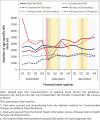How paediatric HIV services weathered the COVID-19 storm in Tshwane District, South Africa
- PMID: 38840712
- PMCID: PMC11151382
- DOI: 10.4102/sajhivmed.v25i1.1557
How paediatric HIV services weathered the COVID-19 storm in Tshwane District, South Africa
Abstract
Background: The coronavirus disease 2019 (COVID-19) pandemic disrupted paediatric HIV services across South Africa. Shortly before COVID-19, updated national HIV guidelines were released.
Objectives: This study describes COVID-19's impact on paediatric HIV services in Tshwane District, South Africa.
Method: A retrospective review of National Institute for Communicable Diseases and District Health Information System data for Tshwane District from April 2019 to March 2022. Data included: Early Infant Diagnosis (EID), HIV viral load (VL) and CD4 monitoring and HIV management among children (< 15 years) living with HIV (CLHIV). Pre-pandemic (2019/2020) and pandemic periods (2020/2021, 2021/2022) were compared.
Results: Year-on-year, HIV testing improved at 10 weeks, 6 months, and 18 months, whereas birth testing decreased. HIV EID case rates were 485 (2019/2020), 410 (2020/2021) and 454 (2021/2022). HIV EID test positivity was 0.77% - 1.2%. Antiretroviral treatment initiation declined from 2019/2020 to 2020/2021, but improved in 2021/2022.Initial HIV VL and CD4 testing declined, with HIV VL testing increasing in 2021/2022, and CD4 testing further declining. HIV VL suppression rate among CLHIV ranged from 69% to 73%.
Conclusion: Initially, COVID-19 resulted in reduced paediatric HIV services as children disengaged from care. Indicators eventually recovered to proximate pre-pandemic levels; however, compensatory increases did not occur. Thus, some children may not have returned to care.
Keywords: COVID-19; HIV management; HIV services; children living with HIV; paediatric HIV; public health.
© 2024. The Authors.
Conflict of interest statement
The authors declare that they have no financial or personal relationships that may have inappropriately influenced them in writing this article.
Figures



Similar articles
-
Monitoring diagnosis, retention in care and viral load suppression in children testing HIV polymerase chain reaction-positive in two districts in South Africa.S Afr Med J. 2019 Aug 28;109(9):686-692. doi: 10.7196/SAMJ.2019.v109i9.13765. S Afr Med J. 2019. PMID: 31635595
-
The initiation of human immunodeficiency virus treatment for children at different levels of care.Afr J AIDS Res. 2020 Dec;19(4):304-311. doi: 10.2989/16085906.2020.1836006. Afr J AIDS Res. 2020. PMID: 33337979
-
Compliance to Viral Load Monitoring Schedules Among Women Attending Prevention of Vertical HIV Transmission Services Before and During the COVID-19 Pandemic in Ehlanzeni District, Mpumalanga, South Africa.AIDS Behav. 2024 Mar;28(3):868-885. doi: 10.1007/s10461-023-04192-z. Epub 2023 Oct 13. AIDS Behav. 2024. PMID: 37831233 Free PMC article.
-
Characterizing Viral Load Burden Among HIV-Infected Women Around the Time of Delivery: Findings From Four Tertiary Obstetric Units in Gauteng, South Africa.J Acquir Immune Defic Syndr. 2020 Apr 1;83(4):390-396. doi: 10.1097/QAI.0000000000002267. J Acquir Immune Defic Syndr. 2020. PMID: 31914002
-
Prevention of vertical transmission of HIV in Khayelitsha, South Africa: A contemporary review of services after 20 years.S Afr Med J. 2023 Oct 23;113(10):14-19. doi: 10.7196/SAMJ.2023.v113i10.861. S Afr Med J. 2023. PMID: 37881910 Review.
Cited by
-
Incidence, Disease Spectrum, and Outcomes of Tuberculous Meningitis in South African Children: The Initial Impact of COVID-19.Trop Med Infect Dis. 2025 May 7;10(5):127. doi: 10.3390/tropicalmed10050127. Trop Med Infect Dis. 2025. PMID: 40423357 Free PMC article.
References
-
- Madhav N, Oppenheim B, Gallivan M, Mulembakani P, Rubin E. Pandemics: Risks, impacts, and mitigation. In: Disease control priorities: Improving health and reducing poverty [homepage on the Internet]. 3rd ed. Washington, DC: The International Bank for Reconstruction and Development / The World Bank; 2017. [cited 2023 Jan 22]. Available from: http://elibrary.worldbank.org/doi/book/10.1596/978-1-4648-0527-1 - DOI - PubMed
-
- Joint United Nations Programme on HIV/AIDS (UNAIDS) . UNAIDS data 2020 [homepage on the Internet]. 2020. [cited 2023 Jan 27]. Available from: https://www.unaids.org/en/resources/documents/2020/unaids-data
-
- Joint United Nations Programme on HIV/AIDS (UNAIDS) . Ending AIDS progress towards the 90–90-90 targets [homepage on the Internet]. Joint United Nations Programme on HIV/AIDS (UNAIDS); 2017. [cited 2023 Mar 03]. Available from: https://www.unaids.org/en/resources/documents/2017/90-90-90
-
- National Department of Health . ART clinical guidelines for the management of HIV in adults, pregnancy, adolescents, children, infants and neonates. Pretoria: National Department of Health; 2019.
LinkOut - more resources
Full Text Sources
Research Materials
Miscellaneous
